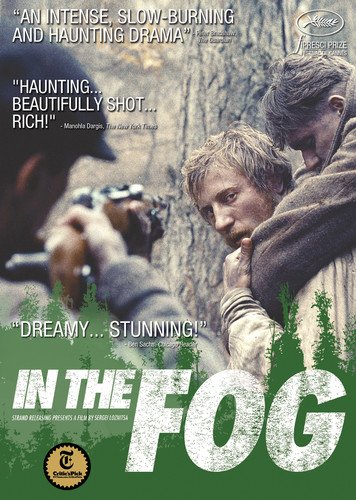
Sergei Loznitsa’s In the Fog is a compelling, careful drama about guilt and honour in the Nazi-occupied Soviet Union. Because the filmmaker refrains from making the 2012 picture a “war movie” by definition, the themes become more universal. And because the themes are more universal, In the Fog‘s power is seductive and masterful.
Loznitsa’s movie is based on a book by Vasil Bykov and takes into account the notion of proving one’s innocence and holding fast to moral law. With the consistency of this parable’s protagonist in mind, the director and his cinematographer Oleg Mutu crafted a “classical” visual style and used only 72 cuts over the 127-minute run-time.
Vladimir Svirskiy stars as Sushenya, a perpetually exhausted Russian railway worker. The audience is introduced to him as he prepares to have dinner with his wife Anelya (Yulia Peresild). A partisan named Burov (Vladislav Abashin) arrives to take him into the forest to shoot him.
Sushenya, it turns out, was part of a railway crew that worked to sabotage a German train in Nazi-occupied territory. He was also the lone holdout and refused to participate over fear of reprisal. When the other members of his crew were captured and hung, Sushenya was let go. Haunted by guilt, he submits without complaint to the partisans’ desires to see him dead.
As in most fables of this sort, things don’t exactly go as planned. Burov and another partisan named Voitik (Sergei Kolesov) move Sushenya through the forest to find a place to shoot him, but they are set upon by Germans. One man is heavily wounded, which once again gives Sushenya an opportunity to illustrate his unwavering morality.
In essence, that’s what In the Fog is about. Sushenya is unrelenting in pursuing his moral being; nothing dissuades him, even threats of death. When he sees the other members of the railway crew hanging, he wishes for death. He considers suicide but decides against it because of the lack of honour in it.
Loznitsa centres his film around the ethics of Sushenya, revealing notes of his character in the flashback sequence where the sabotage is first planned. He is no activist; he just wants to live with his family and defies the idea of innocent people being killed. When the saboteurs suggest that old women will be the only victims, Sushenya insists that they’re all human beings.
The characters of In the Fog all make varying moral judgements. Voitik makes decisions based on self-preservation, for instance, while Burov is less decisive and perhaps more impulsive. Sushenya stands in contrast to them sharply, even as he is denied his chance at an honourable death by the German officer Grossmeier (Vlad Ivanov).
Sushenya also struggles with not being believed. It is insisted that he must have done something to get off the proverbial hook and even his wife doubts his story and questions his integrity. Toward the end of the picture, Sushenya wonders aloud why those he’s known for 37 years fail to believe him but trust the venom of the Germans instead.
Loznitsa’s directorial style wisely draws these points together. He carefully observes his characters, following gazes and invoking long shots. The “monumental” camerawork and the lack of traditional cuts keeps the action fluid. Several sequences stand out, such as when a German soldiers peers directly into the lens while a character hides nearby.
In the Fog concludes with a wonderful dramatic sweep, but it never overreaches. It is a beautifully dark and human tale, a fable for these times of doubt and moral uncertainty. It talks of the inability to trust and the fatalism that only makes sense in times of strife and struggle.